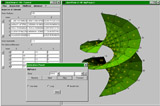JavaView
 JavaView [8] is a software for sophisticated experiments and
visualization of 2- and 3-dimensional geometric objects on a local computer as well as
online in a web browser. Students, teachers and researcher can use JavaView as a tool for
general scientific visualization, in a distant learning environment, for online exchange
of scientific results among researchers, and for electronic publication of mathematical
experiments.
JavaView [8] is a software for sophisticated experiments and
visualization of 2- and 3-dimensional geometric objects on a local computer as well as
online in a web browser. Students, teachers and researcher can use JavaView as a tool for
general scientific visualization, in a distant learning environment, for online exchange
of scientific results among researchers, and for electronic publication of mathematical
experiments.
JavaView is a numerical software library with a 3D geometry viewer
written in Java. It allows to add interactive 3D geometries to any HTML document, and to
present numerical experiments online. The future of mathematical communication is strongly
related to the internet, and JavaView enhances classical textual descriptions not only
with images and videos but additionally with interactive geometries and online
experiments.
JavaView has been developed to solve the following technical tasks:
- Visualization of mathematical data sets inside web pages.
- Interactive experiments and simulations inside web pages.
- Inclusion of mathematical experiments and simulation data in electronic publications.
The first version of JavaView fulfilling these tasks was released in
November 1999 after development versions had been used in geometric research projects at
the Technische Universität Berlin for over a year. JavaView is now used at different
places world-wide. There exist a multitude of mathematical demonstrations to give an
outlook of the range of new applications possible with web-based experimental software.
The first two tasks provide the technical basis for the third task. As
a proof of usability, JavaView has been selected by the project ''Dissertation Online'' of
the German science foundation DFG to produce a reference online dissertation in
mathematics. There are many other issues to solve for electronic research publications,
and JavaView is only one component that is connected with the inclusion of experiments and
interactive visualization. For example, mathematical journals currently require a paper
based version of an article even if they include the article in an electronic version of
the journal too. An author must create two versions of an article, usually a TeX version
for paper-based printing and an online version including, say, JavaView experiments. But
even electronic versions of journals are currently not well-suited for web-based usage
since they are just PostScript or PDF documents. Such documents do not fit with other
internet technologies since, for example, they are hardly searchable and do not allow
inclusion of Java applets or video elements.
In the following subsections we discuss some properties of JavaView and
give a number of sample experiments. Since this book is paper-based we refer to an online
version of this article at the web site
http://www.javaview.de/
which
contains interactive versions of the presented applets.
For more information and an interactive applet, see
here.
 JavaView [8] is a software for sophisticated experiments and
visualization of 2- and 3-dimensional geometric objects on a local computer as well as
online in a web browser. Students, teachers and researcher can use JavaView as a tool for
general scientific visualization, in a distant learning environment, for online exchange
of scientific results among researchers, and for electronic publication of mathematical
experiments.
JavaView [8] is a software for sophisticated experiments and
visualization of 2- and 3-dimensional geometric objects on a local computer as well as
online in a web browser. Students, teachers and researcher can use JavaView as a tool for
general scientific visualization, in a distant learning environment, for online exchange
of scientific results among researchers, and for electronic publication of mathematical
experiments.